| Warm-up
and Saturday Morning
Thankfully, rumours
that the official warm-up would be staged at the
usual time of eight o’clock, despite the
delayed start to this year’s race to make
room in the television schedules for a football
match, proved to be groundless. Like the start
itself, the warm-up was also set back one hour,
and allowed everyone that little extra time to
reach the circuit in the morning. All three RML
drivers took part in the forty-five-minute session,
with Mike Newton and Thomas Erdos doing straightforward
out and in laps to practice their driver changes
before Andy was allowed a few additional laps,
and set a fastest of 3:45.924 right at the end
to be quickest in LMP2. This effectively confirmed
that the final set-up suggestions arising from
Friday’s pre-race briefing had achieved
their objective, and the MG EX264 was really running
very smoothly. Not so the #7 Audi R10 of Allan
McNish, which slowed twice – first time
with a drive-shaft problem, and after that had
been fixed, with smoke coming from the engine.
A quick de-brief
and the three drivers were free to head back to
hospitality and meet up with friends and relatives.
Back out on the track there was activity aplenty,
with a pair of historic races – one for
vintage pre-war cars, and the second for classic
sportscars from the Fifties. The first of these
was hugely entertaining, with a spirited battle
for the lead between Gareth Burnett in a Talbot
105 Alpine and Luke Stevens in an Alta Sports.
The lead oscillated between them for almost the
entire seven laps before Burnett grabbed victory
at the bitter end by lunging across the line to
take the flag by six one hundredths of a second.
Considering these cars average around 60 years
of age, running six-minute laps is no mean achievement.
The post-war race was won by Gary Pearson in his
C Type Jaguar, with Joe Colasacco second in his
splendid Alfa Romeo 3000CM.
If that wasn’t
enough, seven-times Le Mans winner Tom Kristensen
then took to the wheel of one of the latest Audi
DTM racecars and demonstrated its pace –
and his nerves – by performing donuts along
the pit straight, narrowly missing the concrete
pit wall time and time again. With a dense cloud
of rubber smoke drifting slowy across the grandstands,
Kristnesen headed away to get ready for his race,
leaving the track clear for the more sedate spectacle
of this year’s Le Mans cars taking up their
positions on the tarmac, staged in the traditional
herringbone formation that did, until the mid-Sixties,
represent that starting grid for Le Mans races.
These days it is simply part of the spectacle,
made more so by each team’s drivers being
paraded along the main straight perched on the
back of open-topped Audi cabriolets, stopping
on the red carpet, and being presented to the
crowds by Bruno Vanderstick. Mike, Tommy and Andy
went through at just before three o’clock,
with still two hours to go before the start. Somehow
the minutes were filled, with the Hawaiian Tropic
girls and Jan Lammers’ “Dome”
ladies from Japan adding a bit of glamour to the
occasion.
A
great party atmosphere develops, but this suddenly
changes to something more serious as the drivers
are seen coming out towards their cars, and the
national anthems of all the competing drivers
are played out at full volume across the public
address. By this time the cars are hot, the drivers
are hot, and there’s a palpable eagerness
to “get going”.
Race
Start and First Hour
(5:00pm - 6:00pm)
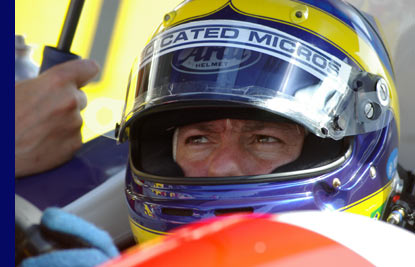 The
cars had been sat out on the tarmac for more than
two hours before the signal finally came for the
drivers to climb into their cockpits and for engines
to be started. It was twenty-past four when Tommy
was helped into the cockpit and strapped aboard
the MG. The journey around the circuit and back
to the grid is a final opportunity for teams to
check that their cars are ready for the race,
and after such a long time in the sun, it is also
an essential part of the process. Tommy was not
alone in using the next quarter-hour to its maximum
potential, and headed straight back down the pitlane,
bypassing the grid, and stopping on the RML apron
for one last splash of petrol and a systems check.
From there he was able to head back out and do
another complete lap before taking up his position
on row six, directly behind the #12 works LMP1
Courage LC70 (with Briton Sam Hancock driving
first stint) and alongside Bob Berridge in the
#19 LMP1 Chamberlain Lola. The
cars had been sat out on the tarmac for more than
two hours before the signal finally came for the
drivers to climb into their cockpits and for engines
to be started. It was twenty-past four when Tommy
was helped into the cockpit and strapped aboard
the MG. The journey around the circuit and back
to the grid is a final opportunity for teams to
check that their cars are ready for the race,
and after such a long time in the sun, it is also
an essential part of the process. Tommy was not
alone in using the next quarter-hour to its maximum
potential, and headed straight back down the pitlane,
bypassing the grid, and stopping on the RML apron
for one last splash of petrol and a systems check.
From there he was able to head back out and do
another complete lap before taking up his position
on row six, directly behind the #12 works LMP1
Courage LC70 (with Briton Sam Hancock driving
first stint) and alongside Bob Berridge in the
#19 LMP1 Chamberlain Lola.
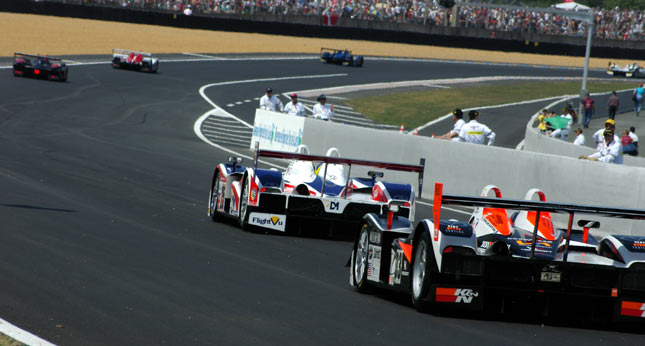
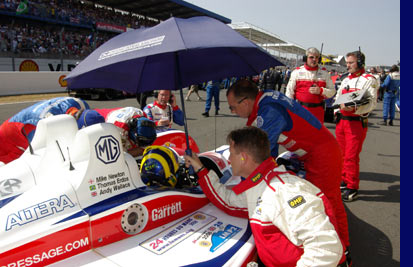 The
wait was not yet over, however, and another twenty
minutes would pass before the Audi TT pace car
finally headed off up the rise towards the Dunlop
Chicane, followed by the first of fifty starters.
The ACO manage to string out this formation lap
to a nail-biting degree, yet they’ve also
honed the timing to a fine art. Accompanied by
stirring music played loud across the public address,
the blazing headlights of the leading group emerged
through the heat haze of the Porsche Curves. Snaking
their way through the Ford Chicane, just the right
number of seconds were left on the clock to ensure
that the roar of engines announcing the start
of the 74th Le Mans 24 Hours echoed out between
the grandstands at exactly five o’clock.
Allan McNish, starting the #7 Audi R10, made an
excellent run across the line, and had the edge
on Frank Biela as they diced for the Dunlop Chicane. The
wait was not yet over, however, and another twenty
minutes would pass before the Audi TT pace car
finally headed off up the rise towards the Dunlop
Chicane, followed by the first of fifty starters.
The ACO manage to string out this formation lap
to a nail-biting degree, yet they’ve also
honed the timing to a fine art. Accompanied by
stirring music played loud across the public address,
the blazing headlights of the leading group emerged
through the heat haze of the Porsche Curves. Snaking
their way through the Ford Chicane, just the right
number of seconds were left on the clock to ensure
that the roar of engines announcing the start
of the 74th Le Mans 24 Hours echoed out between
the grandstands at exactly five o’clock.
Allan McNish, starting the #7 Audi R10, made an
excellent run across the line, and had the edge
on Frank Biela as they diced for the Dunlop Chicane.
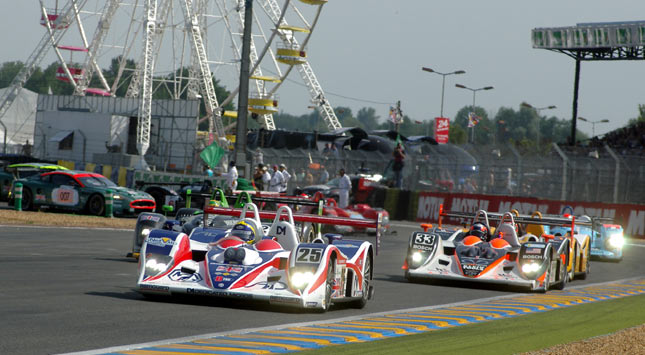
A
little further back Tommy had encountered a slight
a slight loss of power at just the wrong moment,
and Berridge had pulled clear in the #19 Lola,
but within seconds of joining the pitlane straight
the Brazilian had recovered and was pulling clear
of Liz Halliday in the Intersport Lola, drawing
Joao Barbosa through with him into second. Both
cars headed off after the yellow Chamberlain LMP1
Lola, with Warren Hughes an interested spectator
just a couple of positions further back. “I
had a reasonably good start,” said Tommy
later. “Right at the start I got bogged
down in first gear coming out of the Ford Chicane.
It was as though I had no power at all! The engine
just went durrrrrrrrrrr, and I had no acceleration,
no boost, and I fell right back.” He radioed
in to report the problem, but simultaneously,
the engine leaped back into life again.
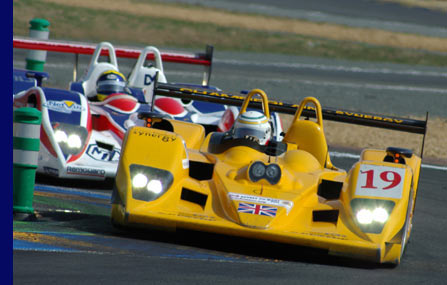 By
the end of the first lap the RML MG was tucked
back under the rear wing of the yellow #19 Lola
and it was evident that Berridge, for the time
being anyway, was cramping the MG’s style.
Not only had Barbosa also been able to close right
up on the back of the RML machine, but Warren
Hughes, benefiting from Liz Halliday’s evident
problems in the Intersport Lola (four pitstops
in the first half hour to address a misfire),
was through to third in LMP2. By
the end of the first lap the RML MG was tucked
back under the rear wing of the yellow #19 Lola
and it was evident that Berridge, for the time
being anyway, was cramping the MG’s style.
Not only had Barbosa also been able to close right
up on the back of the RML machine, but Warren
Hughes, benefiting from Liz Halliday’s evident
problems in the Intersport Lola (four pitstops
in the first half hour to address a misfire),
was through to third in LMP2.
By
the end of lap three Tommy had become more aware
of the fact that the engine was very slightly
down on power, but was steadily coming to terms
with it. Not sufficiently, however, to withstand
the increasing pressure from Barbosa, first, and
then Hughes next. Both cars slipped by in the
space of a single lap, and there was nothing he
could do to respond. “The Radical was swallowing
me on the straights, and out of the corners where
I seemed to have no acceleration at all. I was
pushing as best I could, but once they’d
got up to pace there wasn’t a lot I could
do about it. I was able to change my driving style
a little, and that overcame some of the out-of-corner
problems. In the end, Barbosa came past me out
of Tetre Rouge, and just powered past me on the
straight.”
During
the fourth lap Warren Hughes had also found the
pace – and the space – to sneak through
ahead of Barbosa. His efforts were about to become
somewhat academic, however, when the BMS Scuderia
Italia Aston Martin DBR9, Babini at the wheel,
pitched heavily into the concrete wall along the
Porsche Curves. Two Safety Cars was instantly
deployed, one on each side of the circuit, and
a whole string of cars dived straight down the
pitlane. Hughes and Barbosa were included among
that number, but RML elected to stay out, so Tommy
sailed past the pits and back into the class lead.
It didn’t take long for the marshals to
clear away the stricken Aston Martin, soon to
become the first official retirement from the
2006 Le Mans 24 Hours, a heartbreaking twelve
minutes into the race. Mid-way through the next
lap the safety cars were called in and racing
resumed, gifting Erdos a generous lead over Barbosa
and Hughes.
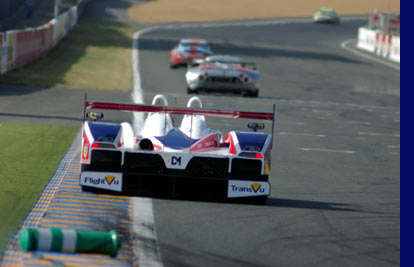 While
Erdos built up a steadily increasing advantage,
the battle for second intensified, with Hughes
finally getting ahead of Barbosa and into second
place in LMP2 at 5:39. Perhaps the MG’s
lead was slightly unrepresentative at this stage,
since the two in pursuit had already made their
first pitstop, and this became evident when the
RML driver was called in for his first scheduled
refuel at 5:46. As Erdos threaded his way through
the tyre-walls at the head of the pit entry, Hughes
and Barbosa came swiftly through the Porsche Curves
behind him, weaved through the Ford Chicane and
into the first and second respectively. The stop
gave the team a moment to address that power-loss
that Erdos had been encountering on the exit of
corners, and with a tweak to the engine map, he
was away again. While
Erdos built up a steadily increasing advantage,
the battle for second intensified, with Hughes
finally getting ahead of Barbosa and into second
place in LMP2 at 5:39. Perhaps the MG’s
lead was slightly unrepresentative at this stage,
since the two in pursuit had already made their
first pitstop, and this became evident when the
RML driver was called in for his first scheduled
refuel at 5:46. As Erdos threaded his way through
the tyre-walls at the head of the pit entry, Hughes
and Barbosa came swiftly through the Porsche Curves
behind him, weaved through the Ford Chicane and
into the first and second respectively. The stop
gave the team a moment to address that power-loss
that Erdos had been encountering on the exit of
corners, and with a tweak to the engine map, he
was away again.
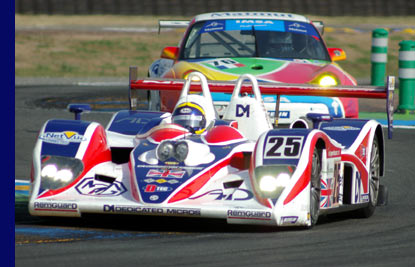 So,
as the race entered its second hour, the #39 Chamberlain
Synergy Lola officially held the class lead from
Joao Barbosa in the #22 Radical and Tommy Erdos
third in the RML MG Lola EX264. It was a brief
exchange of positions, and when the Radical and
Lola both pitted simultaneously at just after
six, Erdos resumed his position at the top of
the class. In relation to overall positions in
the race, this was a very respectable ninth overall,
suggesting that the little MG had three of its
bigger cousins from LMP1 somewhere down the road
behind it. It had been an impressive start to
the race, and came in stark contrast to the events
of twelve months previously, when Tommy Erdos
had already endured several visits to the pitlane,
starting on lap two. What’s more, that change
to the engine mapping had transformed the car
“I really enjoyed my second stint,”
he grinned. “The car was running beautifully,
and we were inside the top ten and leading the
class. That’s so encouraging, especially
when you think about how the race started for
us last year!” So,
as the race entered its second hour, the #39 Chamberlain
Synergy Lola officially held the class lead from
Joao Barbosa in the #22 Radical and Tommy Erdos
third in the RML MG Lola EX264. It was a brief
exchange of positions, and when the Radical and
Lola both pitted simultaneously at just after
six, Erdos resumed his position at the top of
the class. In relation to overall positions in
the race, this was a very respectable ninth overall,
suggesting that the little MG had three of its
bigger cousins from LMP1 somewhere down the road
behind it. It had been an impressive start to
the race, and came in stark contrast to the events
of twelve months previously, when Tommy Erdos
had already endured several visits to the pitlane,
starting on lap two. What’s more, that change
to the engine mapping had transformed the car
“I really enjoyed my second stint,”
he grinned. “The car was running beautifully,
and we were inside the top ten and leading the
class. That’s so encouraging, especially
when you think about how the race started for
us last year!”
Back
to top
Hours
2-3
(6:00pm - 8:00pm)
Thomas
Erdos pressed on for the next half hour, and just
before half past six passed the pits to see “L2”
displayed on the signalling board. It was the
last full lap of his opening double-stint, and
he made the most of it. With the car light on
fuel, but the tyres still at performing brilliantly,
he pushed as hard as he dared, and clocked up
the fastest LMP2 lap of the race so far, clocking
a best of 3:44.572 before beginning his in-lap
– and that wasn’t slow either! His
progress down the pitlane was restricted by the
rev-limiter, but was then further impeded by one
of the GT2 Porsches, which was waved away from
its apron just as the MG was cutting in on its
final approach. Both drivers slammed on their
brakes, and an accident was narrowly avoided,
but it was a close run thing.
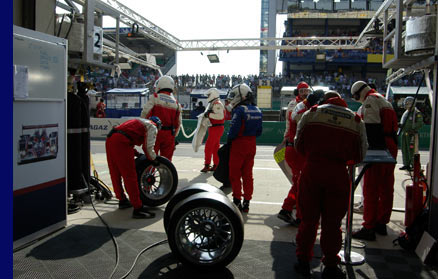 Tommy
had to take an unconventional line to park up
outside the garage, and then be pushed back into
his correct slot before the pitstop could begin.
He was clambering out within moments, and Andy
Wallace, his seat insert in one hand, was rapidly
climbing into the cockpit. While the car was refuelled,
Jason helped Andy into his belts, connected up
his radio, and fitted his drinking tube. Fresh
Michelins were fitted, although a quick inspection
suggested that this set might yet have done another
stint, which came as good news for the cooler
night-time periods ahead, when they might well
be expected to triple-stint the tyres. Tommy
had to take an unconventional line to park up
outside the garage, and then be pushed back into
his correct slot before the pitstop could begin.
He was clambering out within moments, and Andy
Wallace, his seat insert in one hand, was rapidly
climbing into the cockpit. While the car was refuelled,
Jason helped Andy into his belts, connected up
his radio, and fitted his drinking tube. Fresh
Michelins were fitted, although a quick inspection
suggested that this set might yet have done another
stint, which came as good news for the cooler
night-time periods ahead, when they might well
be expected to triple-stint the tyres.
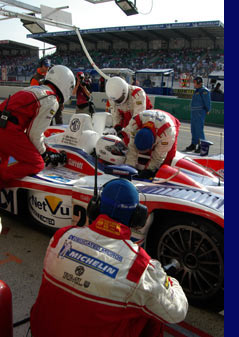 At
6:38 Andy Wallace headed off to begin his first
race stint in the MG Lola. He’d rejoin the
race in third place, with the extended pitstop
having cost a few valuable seconds, but the gap
was narrow despite Gareth Evans being between
Wallace and Barbosa, eleventh, twelfth and thirteenth.
It was now apparent that the rivals were almost
exactly half-an-hour out of sequence on the fuel
stops, but fuel consumption was remarkably similar,
to the point that Warren Hughes and Joao Barbosa
pitted together once again at just after seven
o’clock. Hughes handed over to Amaral, but
Barbosa stayed in for a third consecutive stint,
in the hope perhaps of keeping pace with RML’s
widely-acknowledged superior driver line-up. Wallace,
meanwhile, had passed Gareth Evans in the LMP1
Lola for twelfth overall, and would then move
ahead of Barbosa during the Radical’s pitstop,
leaving him a mere twenty seconds behind Amaral
by the time the second of the Chamberlain Lolas
had completed its driver swap. At
6:38 Andy Wallace headed off to begin his first
race stint in the MG Lola. He’d rejoin the
race in third place, with the extended pitstop
having cost a few valuable seconds, but the gap
was narrow despite Gareth Evans being between
Wallace and Barbosa, eleventh, twelfth and thirteenth.
It was now apparent that the rivals were almost
exactly half-an-hour out of sequence on the fuel
stops, but fuel consumption was remarkably similar,
to the point that Warren Hughes and Joao Barbosa
pitted together once again at just after seven
o’clock. Hughes handed over to Amaral, but
Barbosa stayed in for a third consecutive stint,
in the hope perhaps of keeping pace with RML’s
widely-acknowledged superior driver line-up. Wallace,
meanwhile, had passed Gareth Evans in the LMP1
Lola for twelfth overall, and would then move
ahead of Barbosa during the Radical’s pitstop,
leaving him a mere twenty seconds behind Amaral
by the time the second of the Chamberlain Lolas
had completed its driver swap.
Getting
ahead of Evans was like letting the cork out of
the bottle. The LMP1 machine had proven very difficult
to pass, thanks to its straight-line speed advantage,
but once Andy Wallace had put some clear air between
himself and the LMP1 machine, he was able to ease
ahead rapidly. Having previously been restricted
to whatever pace Evans could maintain, he was
now able to go at his own speed, and it was considerably
faster. From running in the mid three-fifties,
sometimes slower, he was now instantly into the
forty-nines and eights. Barbosa, however, was
also circulating rapidly, and when Wallace headed
down the pitlane for fuel at half-past seven,
the Portuguese driver was able to slip ahead once
again, followed soon afterwards by Amaral in the
#39 Lola.
Back
to top
Hours
4-5
(8:00pm-10:00pm)
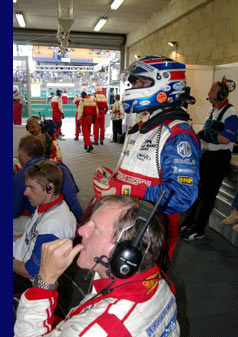 Half
an hour later, of course, the roles were reversed
once again, and Wallace swept back into the lead
as the other two made their next scheduled stops.
By quarter-past eight the MG was standing 7th
overall, leading LMP2 by more than a minute and
a half, and for the first time having enough of
an edge over Moseley, who had taken over from
Barbosa in the Radical, to be considered as leader
by right, not just circumstance. With Andy now
circulating in the low forty-sevens, that margin
was growing, and the #39 Lola was a receding threat
in 9th overall. Two minutes later Andy set his
fastest lap, and also that of the car, with a
best of 3:44.495. It signalled his final flying
lap, and at the end of the next, he was back down
the pitlane to hand over to Mike Newton. “I
was having a great time!” enthused Wallace.
“The car was just getting quicker and quicker,
and there was no tyre degradation whatsoever.
My last lap felt really fast, and turned out to
be my quickest, just like Tommy’s had been.”
The car was obviously behaving itself impeccably.
“It’s perfect - just lovely to drive
- and I could even chase the Pescarolos through
the corners. They can’t get away.” Half
an hour later, of course, the roles were reversed
once again, and Wallace swept back into the lead
as the other two made their next scheduled stops.
By quarter-past eight the MG was standing 7th
overall, leading LMP2 by more than a minute and
a half, and for the first time having enough of
an edge over Moseley, who had taken over from
Barbosa in the Radical, to be considered as leader
by right, not just circumstance. With Andy now
circulating in the low forty-sevens, that margin
was growing, and the #39 Lola was a receding threat
in 9th overall. Two minutes later Andy set his
fastest lap, and also that of the car, with a
best of 3:44.495. It signalled his final flying
lap, and at the end of the next, he was back down
the pitlane to hand over to Mike Newton. “I
was having a great time!” enthused Wallace.
“The car was just getting quicker and quicker,
and there was no tyre degradation whatsoever.
My last lap felt really fast, and turned out to
be my quickest, just like Tommy’s had been.”
The car was obviously behaving itself impeccably.
“It’s perfect - just lovely to drive
- and I could even chase the Pescarolos through
the corners. They can’t get away.”
By
contrast to the previous driver-change between
Tommy and Andy, this one was very straightforward
and trouble-free. Mike was rapidly ensconced within
the cockpit and sent on his way, with the car
refuelled and fitted with another fresh set of
rubber. While this was all happening in the relative
quiet of the pitlane, all hell was breaking loose
behind Clairay in the #36 Belmondo Courage. Heading
down towards Indianapolis along one of the fastest
lengths of track his rear right tyre exploded
spectacularly, ripping the rear of the car to
shreds and pitching him helplessly into the Armco.
Fortunately, for Mike sake, having just completed
his pitstop, the marshals had the wreckage cleaned
up very quickly, and there was no need for the
safety car. Equally fortunate, Clairay emerged
unscathed from what must have been a frightening
encounter. Elsewhere, the #7 Audi was being pulled
backwards into its garage; the first sign of fragility
from an R10.
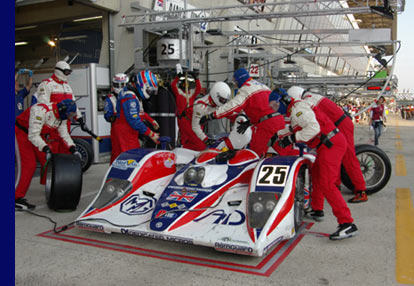 With
a longer than expected pitstop from Amaral in
the #39 Lola, Mike was able to consolidate the
lead he’d taken on from Andy Wallace, and
begin what turned out to be an excellent stint.
By quarter-to-nine he was lying a very impressive
sixth overall, leading LMP2 comfortably from Moseley
in the Radical, with De Castro now third, having
taken over from Amaral. That gap to Moseley was
drastically reduced when Mike made his first pitstop
for fuel at just gone nine o’clock, and
when he returned to the track, the Radical was
just a minute adrift. De Castro, however, would
make a lengthy pitstop at 9:16, and effectively
drop out of the immediate contest. With
a longer than expected pitstop from Amaral in
the #39 Lola, Mike was able to consolidate the
lead he’d taken on from Andy Wallace, and
begin what turned out to be an excellent stint.
By quarter-to-nine he was lying a very impressive
sixth overall, leading LMP2 comfortably from Moseley
in the Radical, with De Castro now third, having
taken over from Amaral. That gap to Moseley was
drastically reduced when Mike made his first pitstop
for fuel at just gone nine o’clock, and
when he returned to the track, the Radical was
just a minute adrift. De Castro, however, would
make a lengthy pitstop at 9:16, and effectively
drop out of the immediate contest.
Mike
and Moseley turned out to be quite evenly matched,
and were trading times pretty effectively. Once
in a while traffic allowed Moseley to post a faster
lap, and little by little the margin did narrow,
from 40 seconds at 9:25, down to 23 seconds ten
minutes later, but then Mike responded, and by
the time Moseley made his scheduled stop shortly
afterwards, it had eased back out to half a minute
again.
With
the Radical pitstop came a change in driver, team-owner
Martin Short taking over the car. The time taken
to refuel and swap with Moseley, combined with
a slightly less competitive pace, effectively
eased the pressure on Mike, and he ended his opening
double-stint at just after ten o’clock having
not only retained the class lead he’d been
given, but extending it. “I’m very
pleased. I had an absolutely wonderful time out
there – the best fun you can have with your
clothes on! We re-mapped the engine earlier, and
it’s now much better – better, in
fact, than it was in qualifying. As for my stint,
the only problem I had was getting out of the
way of one of the Porsches when he cut across
in front of me, and I caught the kerb. Other than
that, it was entirely trouble-free, and I don’t
think I slipped over four minutes for a lap even
once, but sometimes you do wonder if there can
really be any more cars to pass on a single lap!”
It
was time for Thomas Erdos to step back aboard
the MG once again.
Back to top
Hours
6-7 (10:00pm-12:00pm)
This
would be the start of a lengthy treble-stint from
the Brazilian, and one that would see the MG consolidate
its hold on the class lead, and move up as high
as fifth overall. When he started off, however,
his greater concern was the narrow lead of just
44 seconds over Martin Short’s Radical that
he’d inherited from Mike Newton, but with
a succession of laps in the forty-eights, compared
with fifty-fives from the Rollcentre car, that
rapidly extended to over a minute and beyond.
At half-past ten the Radical pitted, and with
De Castro now three laps adrift, the immediate
threat had receded.
At
quarter to eleven Tommy moved up to fifth overall
at the expense of Minassian in the #16 Pescarolo,
who had encountered the first of what would be
several problems for one of the pre-race favourites.
Three minutes later the Radical challenge weakened
significantly in LMP2 when Martin Short pitted
the black and green car with an engine problem.
The car was dragged back into the garage and the
engine cover taken off, but when it was hauled
back out a few minutes later, the V8 steadfastly
refused to use more than half its cylinders, and
the Radical was promptly dragged back into the
garage again, where it would remain for some time.
Tommy
made his first of two scheduled stops just before
the hour, taking on fuel, but without the need
to change the tyres. The crew ripped off the acetate
sheets that had been protecting the headlights
up until this point, instantly clearing away the
combined detritus of five hours hard racing, and
the MG was back on its way. Second in LMP2 as
the race entered its seventh hour was the Chamberlain
Synergy Lola #39, with the Radical steadily falling
out of contention as it remained static in the
Rollcentre garage.
Having
enjoyed his stay in fifth place overall, Tommy
had to relinquish this at 11:05 to Allan McNish,
speeding by in the fast-recovering Audi #8. “I
saw him coming,” admitted Erdos, “but
I never heard him!” The R10s are remarkably
quiet, and it has been a common observation, especially
from GT drivers with closed cockpits, that they
simply cannot hear the Audis coming, and before
they know it, there’s a buffet of wind and
they’ve been lapped . . . again.
The
next half-hour went by without incident, and at
11:39 the MG clocked up its hundredth lap. Still
lying sixth overall, Erdos enjoyed an advantage
of just over two laps on De Castro in the #39
Lola, but now having to keep a wary eye on the
GT1 leading Corvette, number 64, just four minutes
behind and seemingly relentless.
With
ten minutes of the day remaining, Thomas Erdos
made his second stop for fuel. He now had former
RML driver Warren Hughes behind him in second
place driving the yellow #39 Lola, albeit some
distance in arrears, and the Radical a distant
memory. It was time to move into Sunday . . .
Back to top
. . . or on to Sunday >>
Marcus
Potts |
